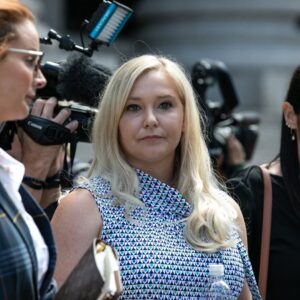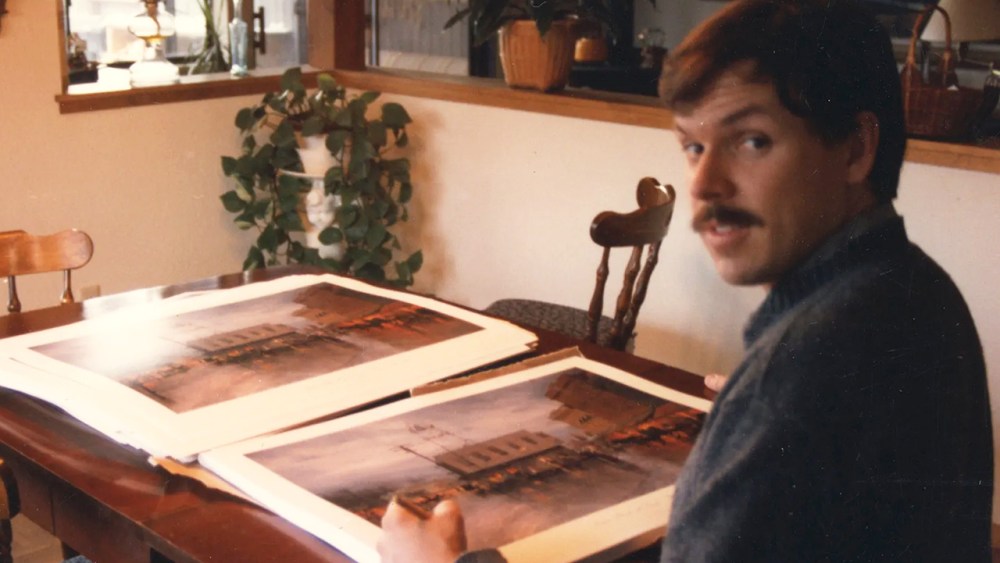In the 1990s, Thomas Kinkade was the most successful artist of his time. His sentimental, sanitized landscapes full of Christian motifs and storybook cottages, some of which were lit with tiny LEDs embedded in the canvas, were so popular that, at one point, it was estimated that one in 20 American houses owned Kinkade artwork via a painting, a calendar, a Christmas ornament, a postcard, a commemorative plate or a La-Z-boy recliner dressed in his fabric.
Kinkade, who died of an overdose of alcohol and valium in 2012, called himself the “Painter of Light.” His trademark art consisted of romanticized environments complete with golden sunsets, an abundance of pastels, and cozy homes that glowed excessively from within. While the masses loved him, the art world despised Kinkade.
In the recently released documentary “Art For Everybody,” director Miranda Yousef reveals that before Kinkade built a multimillion-dollar empire, thanks in part to professing himself to be a man of God, the painter wanted to be like Van Gogh.
“A Quiet Evening” by Thomas Kinkade
JEFF MCLANE
“I want to avoid painting silly and sweet pictures, charming pictures, happy pictures,” a 16-year-old Kinkade says in the film. “I want to paint the truth, and … the truth of this world is pain.”
In the doc, interviews with Kinkade’s family, including his four daughters and ex-wife, archival home videos and tape recordings, as well as dark paintings from his early career, help to shed light on the man behind the brand.
“Art For Everybody” also explores Kinkade’s role as a “televangelist.” A born-again Christian, Kinkdae incorporated his faith and family values into his art. “When I got saved, God became my art agent,” Kinkade explained in a video. But in 2003, the artist was accused of using his Christian faith as a tool to fraudulently induce people to invest in the Thomas Kinkade Signature Gallery – a chain of stores that sold his artwork. Two years before his death, Kinkade filed for bankruptcy protection and was arrested for driving under the influence. He was accused several times of sexual harassment, and had a penchant for “marking his territory,” as the L.A. Times put it, allegedly urinating on a Winnie the Pooh statue outside the Disneyland hotel.
After premiering at SXSW in 2023, Yousef and “Art For Everybody” producers Tim Rummel and Oscar winner Morgan Neville took the film on the fest circuit. In March, Fourth Act Film began a limited nationwide release of the doc in selected theaters.
Variety spoke to Yousef ahead of the doc’s April 29 Los Angeles release at Vidiots.
What convinced you that Thomas Kinkade would make a good subject for a documentary?
Yousef: Friends in the art world told my producing partner, Tim Rummel, and me that there was something interesting and unusual about Thomas Kinkade. I was familiar with the Painter of Light persona and all of those works, so my initial reaction was, shall we say, skeptical. But Tim went ahead and got in touch with the Kinkade estate and they essentially said yes to us, and told us about these hundreds of hours of audio cassettes that (Kinkade) started recording when he was 16 in 1974, and the hundreds of thousands of photographs and the tens of thousands of hours of home and corporate video. When they said, “We also have thousands of (unseen) artworks in a vault,” we just lit up and we knew that there was a story there.
Did Kinkade’s daughters and ex-wife, who were all incredibly candid throughout the film, serve as producers? Did they have any creative control?
No. They didn’t have creative control, and they didn’t invest money in the film. We went to the family and made the case for why we should be the team to do this film, and I said to them, “I don’t want to make a puff piece, but I also don’t want to make a hatchet job. Neither of those is interesting to me. What I really want to do is to find the truth and find the person who is kind of in the middle.” I think that because it had been almost 10 years since his death, they had had time to process everything, and they were ready. I also feel that Kinkade’s persona and his brand cast such a long, dark shadow over all of their lives that their voices were never heard. I wanted to give them the opportunity for their voices to be heard.
Kinkade’s fantasy-like paintings, which included cityscapes with no people of color, appealed to the masses. When you were making the film, did you ever think that this documentary might offer a partial explanation for how America got to where it is today?
The themes and historical moments explored in the film are highly relevant to today. There is a whole section in the film that discusses the late 1980s and the funding battle for the National Endowment for the Arts. That was important to me to include because it was a significant event, and many younger people are unaware of it. I see that as the seeds of the culture war, and Kinkade just stepped right into the breach. I found that to be really fascinating.
Washington Post art and architecture critic Philip Kennicott recently criticized the film for being a redemption story about a man who was a fraud and swindler. What is your response?
I think that he misunderstood my intent. He seemed to think that the film was one of those estate-fueled, like autobiographical things that is designed to sell more product. What a lot of other people have highlighted about the film is how balanced it is. That’s really what I was trying to do. I am not trying to make a judgment call about the quality of any of Kinkade’s works or the aesthetic value of any of his works. To me, what’s more interesting and important is the fact that that other body of work exists at all. That’s really the key, I think, to the whole story.
Is the plan to monetize the unseen vault work?
I can’t speak to the family’s plans for the vault works, but I do know that they want them to be seen and shared with the public. So I think they are trying to figure out some way to do that.
In his review for Variety, critic Peter Debruge said that “Much like Penny Lane’s endlessly amusing ‘Listening to Kenny G,’ Yousef’s illuminating doc appeals to all sides.” Did “Listening to Kenny G” serve as an inspiration when you were crafting this documentary?
Both films are talking about this big question about what is art and who gets to decide? There is a tension that Kinkade actually brings up in the very beginning of our film, when he says, “I don’t want to be Van Gogh because I don’t want to starve, but I also do want to be Van Gogh.” That tension between wanting commercial success and also achieving canonical greatness is something that all artists feel in all media and all art forms. The fact that he had recorded that when he was 16 – it was a documentarian’s dream.
Read the full article here








